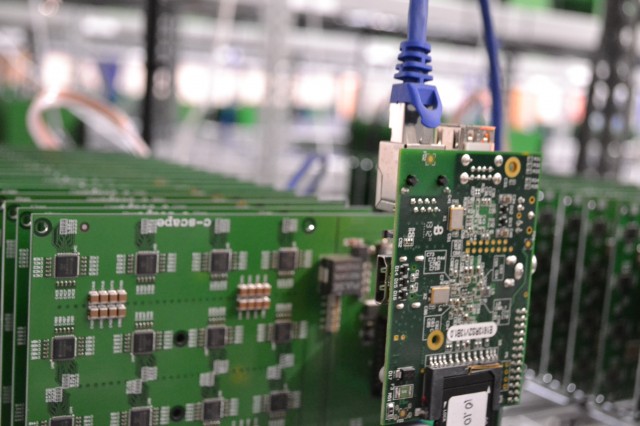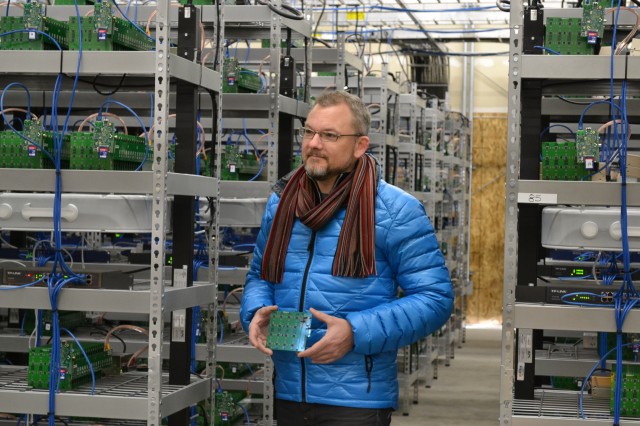
In a couple of large buildings near the Columbia River in Eastern Washington, where hydroelectricity is cheap and plentiful, Dave Carlson oversees what he says is one of the largest Bitcoin mining operations on the planet.
At any given time, Carlson's goal is to account for seven to 10 percent of the entire world's Bitcoin mining as measured by processing or hashing power, he said. At the moment, he's slightly below that target but doesn't expect to remain below it for very long. The operations are fueled by thousands of mining rigs containing more than 1.4 million BitFury mining chips, while Raspberry Pis loaded with custom software direct traffic on each rig.
"We were looking for the lowest cost, highest volume production, tiny computer controller that had the ability to integrate with another electronic board design. There are many out there, but the Raspberry Pi is something like 40 bucks," Carlson told Ars.Carlson's company, MegaBigPower, does the biggest portion of its mining on behalf of its primary investor, the BioInfoBank Institute in Poland. Carlson takes a cut in bitcoins and rents capacity to other people who want to mine without running their own hardware and software.
"We surface about half of our US mining power as something you can purchase as a leased hash product," he said.

If you really want to get into Bitcoin mining, it may well be better to run your own hardware than lease hashing power from someone else. Not having any desire to handle the specifics of mining could be a good reason to pay someone else to do all the work. But if Carlson can make money by leasing out mining capabilities and taking a percentage of mined bitcoins, someone who's willing to research the appropriate hardware and configurations themselves should probably just go it alone and reap all the Bitcoin profits.
Nonetheless, MegaBigPower offers a fascinating look at how a small group with money and ambition can account for a disproportionate share of the decentralized Bitcoin network. Carlson's team has fewer than 10 core members, including a CTO, a product manager, and operational, technical, and facilities people.
Carlson mined on his own before starting MegaBigPower, but despite the cut he takes from the current mining operations, none of the hardware is dedicated just to his own Bitcoin wallets. "If I start running my own mining hardware, inevitably I'm going to favor the management of that hardware over the management of my investors' hardware," Carlson said. "It creates a bit of a conflict of interest, so I've stayed away from it."
Still, he said he owns about 5,000 bitcoins (not including about 1,100 on the failed Mt. Gox exchange), worth about $2.9 million at a recent Bitcoin price of $585 per coin. "Other than to diversify some of it away from this high-risk volatile asset, I intend to hold a lot of it long-term. I don't think Bitcoin is done yet," Carlson said.
Carlson said he takes about 10 to 20 percent of all mined bitcoins. "I hold most of my Bitcoin. I give some out to my employees, and I spend very little of it," he said.

Building the business
The first rigs were delivered in July 2013 after about a year of planning, board design, and manufacturing (more technical detail is available here). Carlson's team achieved its first "petahash" of mining power—a thousand trillion or quadrillion hashing calculations per second—in January. It's up to about 2.2 petahash now across two facilities in Washington state and a third in Poland.
This requires a lot of electricity. Carlson said more than three megawatts fuel MegaBigPower's global operations, including Poland. The two buildings in Washington are about 16,000 square feet total, with just about all available space used for mining and power equipment. Carlson said he's "bumping up" against the maximum amount of electricity he can get into his buildings.
Carlson has to keep expanding and upgrading his processing power to remain at seven to 10 percent of the world's Bitcoin mining. Global hashing power is estimated at about 39.5 petahash, putting Carlson's 2.2 petahash at about 5.6 percent of the world's total. Carlson intends to add another petahash within a month, bringing his percentage up to about 8 percent.
Toward that end, he's soon opening a third facility in Washington and rolling out a new rig design. The current rigs each contain 16 boards, with each board containing 16 BitFury chips, for a total of 256 mining chips on each rig. Carlson said about 90,000 processor boards have been deployed, which would put the number of rigs at about 5,600.
A new board MegaBigPower is designing will have 756 chips on each rig instead of 256.
"We are aggressively building out our mining facilities on both sides of the world, and we're shooting for keeping it level, but the reality is that difficulty rises exponentially, and it's hard to build out exponentially at that same rate," he said.
Right now, MegaBigPower can mine 7,000 to 8,000 bitcoins per month, he said. Bitcoin to dollar exchange rates go up and down all the time, but at a price of $585 per bitcoin, that's $4.1 million to $4.7 million. When Bitcoin prices topped $1,000 in January, the monthly yields were worth up to $8 million.
How does mining work, anyway?
Bitcoin mining is the kind of thing that sounds befuddling the first time you hear about it, and perhaps even the 100th time you hear about it. Carlson likens digital coin mining to creating a large transaction clearing house. Imagine that Visa, instead of processing credit card transactions inside its own data centers, outsourced the work to whoever had the proper equipment and used transaction fees to pay rewards to the people who successfully processed those transactions on Visa's behalf.
In addition to transaction fees, mining creates new bitcoins that are awarded to successful miners. Of course, the specifics are more complicated. A Bitcoin.org FAQ explains mining as follows:
Mining is the process of spending computing power to process transactions, secure the network, and keep everyone in the system synchronized together. It can be perceived like the Bitcoin data center except that it has been designed to be fully decentralized with miners operating in all countries and no individual having control over the network. This process is referred to as "mining" as an analogy to gold mining because it is also a temporary mechanism used to issue new bitcoins. Unlike gold mining, however, Bitcoin mining provides a reward in exchange for useful services required to operate a secure payment network. Mining will still be required after the last bitcoin is issued.
Anybody can become a Bitcoin miner by running software with specialized hardware. Mining software listens for transactions broadcast through the peer-to-peer network and performs appropriate tasks to process and confirm these transactions. Bitcoin miners perform this work because they can earn transaction fees paid by users for faster transaction processing and newly created bitcoins issued into existence according to a fixed formula.
For new transactions to be confirmed, they need to be included in a block along with a mathematical proof of work. Such proofs are very hard to generate because there is no way to create them other than by trying billions of calculations per second. This requires miners to perform these calculations before their blocks are accepted by the network and before they are rewarded. As more people start to mine, the difficulty of finding valid blocks is automatically increased by the network to ensure that the average time to find a block remains equal to 10 minutes. As a result, mining is a very competitive business where no individual miner can control what is included in the block chain.
Carlson explained that at any given time, Bitcoin miners are searching for a target value. "It's not much different from all the gold miners in the world digging in the dirt trying to find gold," he said. "All the miners in the world are looking for a value that qualifies as difficult enough to satisfy the current block target."
reader comments
200